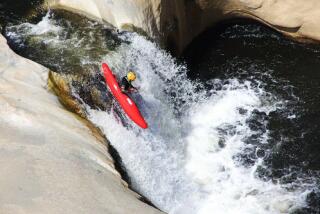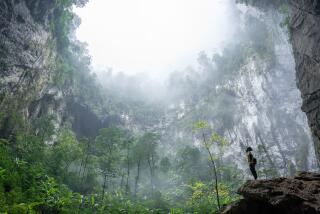Marvels Abound Deep Within for Cave Explorers : Mexico: Team descends to 4,839 feet, the deepest that humans have gone in a cavern in the Western Hemisphere. One dies in the attempt.
- Share via
WASHINGTON — I gazed at these marvels in profound silence. Words were utterly wanting to indicate the sensations of wonder I experienced. To give body and existence to such new sensations would have required the coinage of new words.
--Jules Verne
“A Journey to the Centre of the Earth”
One hundred thirty years later, words still fail the explorers who venture into the Earth.
“The whole thing is pure exploration,” said Bill Stone. “If you haven’t been there, you can’t understand it.”
For 44 days this spring, Stone and his teammates were underground in a natural abyss in southern Mexico, descending three-quarters of a mile vertically under the surface, then swimming through a half-mile-long underwater tunnel to an air-filled cavern.
They eventually got down to 4,839 feet--just short of a mile--the deepest humans have gone in a cave in the Western Hemisphere, the fifth deepest in the world. One member of the expedition died in the attempt. Why did they do it?
“It’s unknown territory down there,” Stone said. “It’s basically the last bastion on this planet of truly manned geographical exploration. If you ask, ‘Who has been doing exploration in the last 30 years?’ you can pretty much say it’s been 12 Apollo astronauts who set foot on the moon and the cave explorers of the world.”
Not spelunkers. Not even cavers. Explorers.
“I think of myself as a modern-age explorer; that’s what this is all about,” Stone said. “It happens to be the frontier right now.”
This particular frontier, Sistema Huautla, is a 35-mile-long complex of interconnected deep limestone caverns in the Mexican state of Oaxaca. Previous attempts at exploration of the cave were stopped by a passage flooded to the ceiling with water. No scuba diving equipment was adequate.
When he’s not rappelling down a shaft or swimming through nearly opaque water underground, Stone, 41, is a research structural engineer at the National Institute of Standards and Technology in Gaithersburg, Md.
With eight colleagues, he designed a life-support system that allows a swimmer to remain underwater for 6 to 8 hours--twice that when two units are joined.
Their goal was a “sump” at the deepest known point in the Mexican cave where the water completely filled the sloping tunnel. The explorers were to don their backpacks and swim into the watery obstacle, seeking a way on to presumed air-filled passages on the other side.
“You cannot get to where we got this year with traditional scuba-diver apparatus,” he said. “It’s just too inefficient, blowing away all that gas every time you breathe underwater.”
His device is based on the space-suit principle, but it’s more complicated because built-in computers adjust a helium-oxygen mixture for the diver, while astronauts set and forget their pure oxygen flow. Exhaled gas is recirculated to remove carbon dioxide by a special process.
Cave explorers carry in their heavy equipment and supplies and bring most of it out. Their ethic is not to litter.
“Ten thousand feet of rope, over 100 shafts you have to go up and down every time you carry something to the dive site,” Stone said of the Mexican cave. “You are also carrying your body weight in addition to whatever your cargo is.”
Stone weighed 210 pounds when he left home on Jan. 15 and 189 when the expedition ended in June. The weight-saving effort extends to food, too. The explorers grind freeze-dried food into dust, and compress it into gallon-sized plastic bottles to avoid carting the foil wrappers in and out.
“We can get 15 man-days’ worth of food in a gallon,” Stone said.
To reach the underwater passage, Stone’s team--which numbered up to 20 at times--rigged more than two miles of rope down large, steeply descending tunnels, following a river most of the way. There were 60 sheer drops--the longest 360 feet--in inky blackness punctuated by the hiss of falling water and lit only by the puny glow of their headlamps.
The cavers also needed to string ropes to cross 30 other places where the boiling underground river was too dangerous to wade or swim.
The air temperature was near 70 degrees--fresh and pure. But with 100% humidity, the cavers sweated profusely inside their colorful nylon coveralls as they hauled 50-pound loads of gear across giant rock falls in monstrous chambers with ceilings too high to be seen, across slippery surfaces.
The first members of the team to make test dives into the deep sump were Noel Sloan, 40, of Indianapolis; Steve Porter, 41, of McKinney, Tex.; and Ian Rolland, 30, of St. Andrews, Scotland. They laid 800 feet of guideline at depths up to 80 feet underwater to find their way back out. Four days later, Rolland and Kenny Broad, 28, of Miami, began diving in earnest.
They poked into numerous dead ends before Broad succeeded in finding a way through the sump--a final distance of 1,400 feet underwater where visibility often was less than five feet. On an ensuing trip, Rolland was continuing in an air-filled chamber beyond the sump when he apparently had a hypoglycemic blackout caused by diabetes. He had the treatment in his pocket, two power bars.
“The insidious thing about hypoglycemia is that it impairs your judgment first,” said Stone, who labored for six days with others to bring the body out. “Had he eaten those two candy bars, he would still be here.”
Stone and Barbara am Ende, 34, a student at the University of North Carolina, made the final dives that got them through yet another sump and into huge air-filled tunnels. They found more than a mile of tunnels--sometimes more than 150 feet wide--and six more sumps they were able to bypass. But they finally were stopped by another massive underwater tunnel, named Sump 9, that they couldn’t get around.
Alone and far from any help, they decided they had explored far enough. Whatever lies beyond Sump 9 will have to await future expeditions.
Where they stopped, Stone said, is considered the most remote point yet reached by humans inside the Earth, 4,839 feet deep and miles from where they entered the cave.
He figures there’s another 3 miles as the crow flies from the point where the explorers left off to the springs. That’s probably many miles through twisting underground tunnels and about two years of effort. He may try it next year, during the dry season, starting at the springs.
In Jules Verne’s 19th-Century vision, the explorers reached the center of the Earth, where monsters roamed and great storms raged.
So far, humans have managed to penetrate the 7,900-mile diameter of the Earth only to a depth of 8,000 or so feet--in shafts of the diamond mines of South Africa.
That doesn’t keep people like Stone from trying to go deeper.
“The indescribable lure of the whole thing is putting that footprint there,” he said. “Just as Neil Armstrong was trying to get on the moon, being the first human being ever to see terra firma incognita is what it’s all about, going into the black unknown.”
More to Read
Sign up for The Wild
We’ll help you find the best places to hike, bike and run, as well as the perfect silent spots for meditation and yoga.
You may occasionally receive promotional content from the Los Angeles Times.






